Unlocking IP wealth
30 April 2025

How do you fully capitalize your IP? Excel V. Dyquiangco details best practices, market analysis and international filing systems, illustrating how businesses can enhance revenue and competitiveness within a legal framework.
These days, intellectual property is more than just a legal asset – it’s a powerful revenue driver. Companies that strategically monetize their patents, trademarks and copyrights can unlock new income streams, strengthen market positioning and fuel innovation. But without the right approach, valuable IP can remain underutilized, leaving potential earnings untapped.
To fully capitalize on their IP, businesses must explore strategies such as licensing agreements, direct sales and partnerships that maximize the value of their assets. At the same time, they need to navigate legal considerations and adopt best practices that ensure long-term sustainability. When taking such a proactive approach, companies can turn their intellectual property into a key engine for growth and competitive advantage.
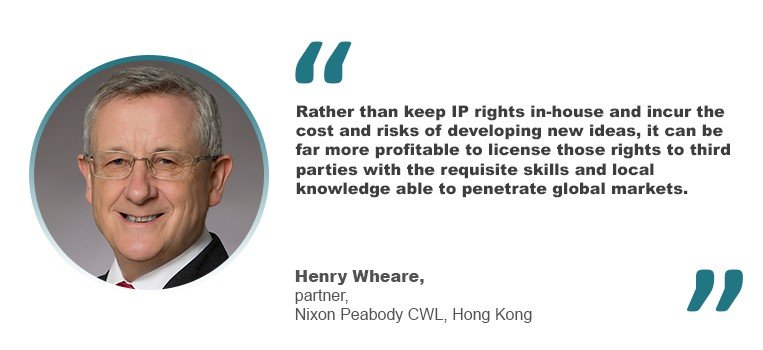
“In an increasingly decentralized world coupled with the cost and difficulty in enforcing IP rights across borders, the licensing of IP rights is becoming an attractive option,” said Henry Wheare, a partner at Nixon Peabody CWL in Hong Kong. “Rather than keep IP rights in-house and incur the cost and risks of developing new ideas, it can be far more profitable to license those rights to third parties with the requisite skills and local knowledge able to penetrate global markets.”
He added: “Since IP rights are essentially territorial, market analysis is required to determine where to register and protect rights. Record keeping for copyright purposes is important because this arises automatically and is most suited to global licensing. All too often, potential licensors omit to have relevant rights assigned to them, forgetting that the authors are generally the first copyright owners even in the case of commissioned works.”
Wheare said that for registered rights, international applications, such as those under the Patent Cooperation Treaty (PCT) or the Madrid trademark filing systems, can be a way to spread the upfront costs and allow time for strategic decisions to be made on which markets to cover.
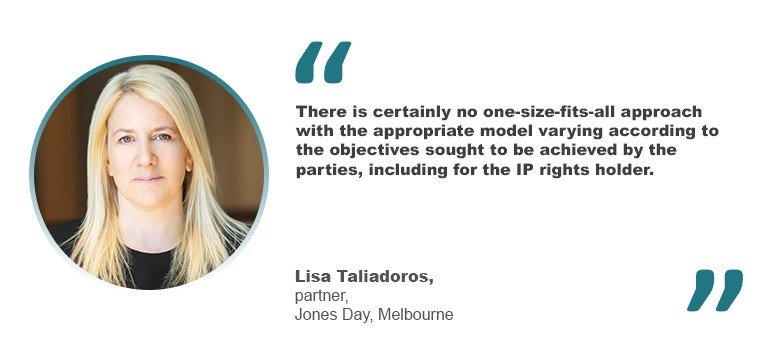
According to Lisa Taliadoros, a partner at Jones Day in Melbourne, while the Asia-Pacific region is diverse in a legal and commercial context and IP rights are by their very nature territorial, the region offers tremendous opportunity for businesses to achieve significant growth and market expansion by adopting a coordinated strategic approach.
“A preliminary question to be addressed in determining licensing strategy is the nature of the licensing model to be implemented,” she said. “There is certainly no one-size-fits-all approach,” she noted, as the best model depends on the parties’ goals. For IP rights holders, this might involve generating passive income, entering new markets without significant investment or even sharing critical technology with competitors in certain cases.
She added: “Importantly, at the outset, consideration should be given to whether any licence is to be exclusive (including potentially excluding the IP holder itself from exploiting its own IP) or will permit the involvement of additional licences (and in the case of the latter, how any division of rights is to operate across all rights holders). Another option may be to employ a franchising model which governs the use of IP (and includes a licence) but which also (in brief) provides the franchisor, the IP holder, with control over the franchisee’s business operations (as part of the franchisor’s business model or concept). This model may have the advantage of limiting the financial investment required by the franchisor in entering new markets, but in some jurisdictions, it comes with a strict regulatory overlay. In Australia, the Franchising Code of Conduct is regulated by the Australian Competition and Consumer Commission.”
Taliadoros said there may be instances where maintaining ownership of IP is unnecessary or disadvantageous and an assignment of rights for compensation is the most appropriate approach. However, she said, such a strategy involves an irrevocable transfer of IP and should be undertaken only after a careful analysis of the impact on the existing business.
“In all instances, it is critical to have a well-prepared agreement or set of agreements giving effect to the arrangements. In the licensing model, this should include clarity as to the IP being licensed, the scope of the licence (including as to duration and territories covered), any royalties or licence fees payable, ownership of any improvements in the IP, performance obligations, brand guidelines (for trademarks), rights of action against third-party infringements, rights of licensee to challenge the IP (if any) and termination rights,” she said.
She added: “For all licences, particularly in relation to trademarks, it is imperative to have regard to the level of control that must be imposed by the licensee over the IP. For example, under Australian trademark law governed by the Trade Marks Act 1995, a trademark becomes vulnerable if the trademark owner does not exercise actual control sufficient to ensure that the mark continues to operate as a ‘badge of origin’ connecting the trademark and the goods or services for which it is used to the trademark owner. That control may be quality control or financial control, but the Australian courts have accepted that other forms of control may also be sufficient.”
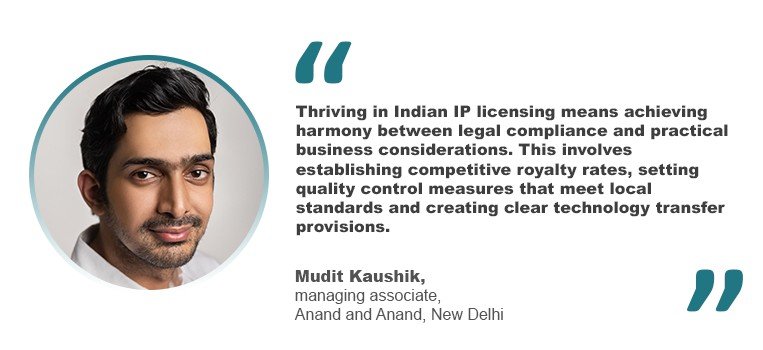
Navigating the licensing agreement
In India, licensing intellectual property requires a solid grasp of the legal framework as well as the ability to identify and monetise IP assets effectively, said Mudit Kaushik, a managing associate at Anand and Anand in New Delhi.
“While India has a well-established IP regime, it is important for companies, businesses and individuals to navigate the complexities involved in a licence agreement and strike a balance to ensure interest of both parties,” he said. “Companies must master local registration and ownership rules to effectively license their IP. Clear documentation is critical, especially when working with Indian partners. Technical specifications, quality standards and usage rights must be clearly defined to avoid disagreements. Evaluating potential licensees requires careful scrutiny of their financial health and IP management history. Agreements should include specific terms for licence scope, payment structures and dispute resolution methods, all whilst complying with Indian regulations on technology transfer and fees. IP valuation is a critical aspect in the licensing deals as accurate IP valuation ensures a fair deal to determine the royal rates in a transaction.”
He added: “Thriving in Indian IP licensing means achieving harmony between legal compliance and practical business considerations. This involves establishing competitive royalty rates, setting quality control measures that meet local standards and creating clear technology transfer provisions. Building strong relationships with Indian licensees is essential, encouraging trust and open communication. Regularly checking how licensees use the IP can ensure compliance, whilst maintaining open dialogue allows for quick resolution of problems. By adopting these strategies, companies can successfully engage with India’s IP environment and create mutually beneficial partnerships.”

His colleague Madhu Rewari, a partner at the same firm, said that among the hurdles to be passed for this to be implemented smoothly is the rise of sophisticated counterfeiters which presents a substantial enforcement challenge, as these operators often use temporary setups and quickly change their business names and locations when detected.
She said: “To address this evolving threat, courts have implemented dynamic injunctive relief through John Doe orders, allowing rights holders to act against unknown infringers and extend enforcement across multiple locations and entities. In parallel, artificial intelligence (AI) is proving to be both a boon and a bane in the fight against counterfeiting. On one hand, AI-powered tools enable automated scanning of ecommerce platforms, social media and online marketplaces, allowing rights to swiftly identify counterfeit products, track unauthorized sellers and take timely enforcement action. On the other hand, the same technology is being exploited by infringers. AI is being used to create deceptive product listings, generate near-authentic counterfeit images and circumvent detection. This dual nature of AI demands the urgent need for an ethical AI framework to ensure that these technologies are harnessed for protecting innovation. Customs authorities play an essential role in this enforcement ecosystem by monitoring and intercepting infringing goods at borders. Companies can enhance their protection by recording their IP rights with customs authorities, enabling officials to identify and seize counterfeit products before they enter domestic markets.”
“The increasing globalization of business operations creates opportunities for multi-jurisdictional IP enforcement strategies. Companies must coordinate enforcement actions across different territories whilst ensuring uniform protection standards. This requires developing integrated approaches that work effectively across various markets and legal systems and consistent monitoring practices. This integrated approach allows companies to respond swiftly to infringement across multiple jurisdictions,” she added.
According to Rewari, digital platforms and ecommerce present another key enforcement area, as online sales channels can quickly distribute infringing products across multiple markets.
“Companies are addressing this through advanced digital monitoring tools and by working directly with ecommerce platforms to implement takedown procedures. Building partnerships with law enforcement agencies, customs officials and industry associations further strengthens these enforcement capabilities, enhancing information sharing and enabling more targeted actions against infringement activities,” she said.
Wheare added that competition law aspects are a possible concern especially with long-term exclusive licences containing restrictive covenants and pricing controls. “Related technology transfer rules, such as in mainland China, may also be relevant in terms of the length of the licences of time-limited IP rights (especially patents) and prohibitions on export bans,” he said.
He added: “Express provision should also be made to ensure the licensee is prevented from acquiring any of the licensor's rights, such as by locally registering the licensor's name or trademarks including in a local language unbeknownst to the licensor.”
“Improvement clauses can also be incredibly important, resulting in total loss of rights through the back door of so-called improvements if not properly drafted. In such circumstances, different considerations apply to licensors and licensees. A licensor will want to own all rights (including the right to apply for IP protection) in improvements, broadly defined, whilst the licensee will want to have the right to exploit such improvements, narrowly defined within the scope of the project and licensed royalty-free,” he said.
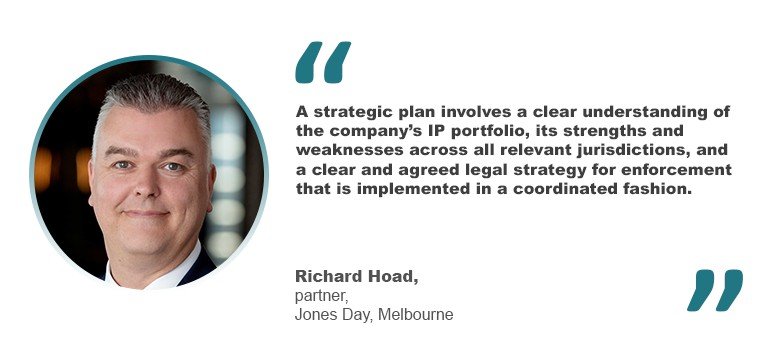
Enforcing business IP rights
Richard Hoad, a partner at Jones Day in Melbourne, said that a prerequisite to any enforcement of rights (against third parties) is an understanding of the nature of the business IP rights and their strength.
“This requires companies to have in place robust systems for identifying, applying for, and maintaining key IP rights, with regular and comprehensive audits and taking steps as required to ensure the validity of these rights,” he said. “This is particularly significant as enforcement actions are often defended by claims that the IP being asserted is invalid. When successful, such claims can have far-reaching consequences, including the inability to assert IP not only against the party that successfully defends a claim of infringement but also as against all in that jurisdiction (and may adversely impact rights in other jurisdictions also).”
“The enforcement of IP rights is a costly and complex exercise, with costs in addition to legal and court fees including those arising from the time which the business team often must devote to any dispute, particularly in court proceedings. The inherent uncertainty that accompanies litigation is also a business cost that should be factored into any decision to enforce IP,” he said.
He suggested that these issues in enforcing IP rights can be mitigated to a degree by way of a strategic plan for enforcement that is in place well ahead of any enforcement action (to the extent possible).
“This involves a clear understanding of the company’s IP portfolio, its strengths and weaknesses across all relevant jurisdictions, and a clear and agreed legal strategy for enforcement that is implemented in a coordinated fashion across all relevant jurisdictions. Aspects of this strategy may include determining who is best placed to identify and assert IP rights in a particular jurisdiction or market – where rights have been licensed, this issue needs to be expressly addressed in the terms of the licence, both to ensure that the licence sets out relevant obligations including as to bringing an action for breach of IP and control of that action (including liability for costs) and also to ensure that the nominated party has the right to do so. For example, in Australia, under the Patents Act 1990, only the patentee or an exclusive licensee (as defined under the Patents Act 1990 in a prescriptive manner) has standing to bring an action for patent infringement,” he said.
Another often important part of the strategy is the ability to move promptly to bring an enforcement action at the commencement of any breach of IP rights, or even before in some cases.
Hoad said: “This approach provides an opportunity to resolve disputes ahead of legal proceedings; in addition, it may enable the IP holder to prevent alleged infringing goods entering the relevant country (through Customs seizure processes, which are available in the case of alleged trademark infringement) and may permit the IP holder or licensee to obtain an interlocutory injunction, enjoining the alleged infringer from commencing the infringing activity pending resolution of the dispute. These strategies protect the IP rights holder from the risk of irreparable financial and other harm that is not fully compensated by an award of damages if the infringer remains in the market during protracted litigation. Such an approach may also favour an early resolution of the dispute through a negotiated settlement.”
He added: “A key element of this strategy is implementing some form of surveillance and reporting system to identify possible infringements at the earliest point in time.”
In addition, to maximize the value of their IP portfolios, Rewari suggested that companies should identify and invest in emerging technology sectors that offer substantial growth opportunities. “This involves strategic analysis of market trends to pinpoint areas where innovation intersects with market demand,” she said. “For example, developments in artificial intelligence, clean technology and digital healthcare represent key sectors where IP assets can generate significant returns. By building IP portfolios that align with these growth areas, companies position themselves to capitalize on licensing opportunities, strategic partnerships and potential market expansion. Regular portfolio reviews help ensure IP investments remain focused on technologies with strong commercial potential.”
She continued: “The strategic management of IP portfolios requires companies to implement systematic evaluation and monetization processes. This includes conducting thorough IP audits to assess the commercial viability of existing assets and identify untapped opportunities for value creation. Companies should explore diverse monetization strategies, from traditional licensing agreements to innovative collaboration models that can generate new revenue streams. By developing comprehensive IP protection strategies around their core technologies, companies can strengthen their competitive position and enhance their ability to secure advantageous commercial arrangements.”
Kaushik added that companies must start by conducting thorough IP searches to ensure uniqueness and avoid potential disputes. Once confirmed, registering IP with appropriate authorities is essential to gain legal protection and exclusive rights. Additionally, establishing internal IP policies and procedures is important for maintaining these assets.
“Regularly conducting audits of IP portfolios is crucial for identifying and plugging any gaps. This process helps ensure that all valuable IP assets are adequately protected and any potential vulnerabilities are addressed promptly. Companies must also adopt proactive measures to monitor the market for any unauthorized use of their IP. This vigilance ensures that any infringement is promptly identified and addressed. Legal actions might be necessary to enforce IP rights and prevent misuse, thereby preserving the brand’s value. Employee training on IP awareness plays a key role in this ecosystem, as well-informed employees are less likely to inadvertently leak or misuse sensitive information,” he said.
A recent example that highlights the importance of leveraging IP for financial and legal advantages is the Fortis trademark auction case. The Delhi High Court’s decision to order the public auction of Fortis Healthcare’s trademark to enforce an arbitral award and recover a debt owed to Daiichi Sankyo serves as a precedent.
He said: “This case illustrates how intellectual property can be a potent tool not only for business operations but also for debt recovery and legal enforcement. By monetizing their IP through public auctions, companies can effectively address financial obligations and demonstrate the strategic importance of their intangible assets. This decision emphasizes that intellectual property is not merely a passive asset but one that can be actively managed and utilized in various legal and financial contexts.”
IP and government support
Governments can encourage the development and commercialization of IP in myriad ways. This includes implementing policies that provide meaningful incentives for research and development (R&D), product development and commercialization and encouraging third-party (including offshore) investment in these activities. In Australia, for example, this includes direct government funding provided through Cooperative Research Centres and numerous government grants across industry sectors.
“Since July 2021, Australia has also had in place the R&D Tax Incentive Program aimed at incentivizing investment into Australian research and development ventures by providing a tax offset to companies undertaking R&D activities in Australia,” said Taliadoros. “In the first published R&D tax incentive transparency report dated October 3, 2024, the Australian Taxation Office reported that a total R&D expenditure of A$11.2 billion (US$7.3 billion) was claimed in the 2021-22 income year with public and multinational companies claiming A$4.9 billion (US$3.2 billion).”
She added: “In addition, governments can partner with business and industry to actively participate in (and drive) R&D through collaboration with Australian universities and other public sector research institutions. An example is Australia’s Economic Accelerator (AEA) Program which provides A$1.6 billion (US$1.04 billion) in funding (over 10 years to 2033) to universities to partner with industry with the aim of commercializing proof-of-concept or proof-of-scale projects which are commercially ready or have high commercialization potential. An example is the University of New South Wales Biosensor team (a collaboration between Biopoint Pty Ltd and researchers at the University of New South Wales), funded by the AEA, that developed portable test strips that detect Covid RNA with a PCR-level of accuracy.”
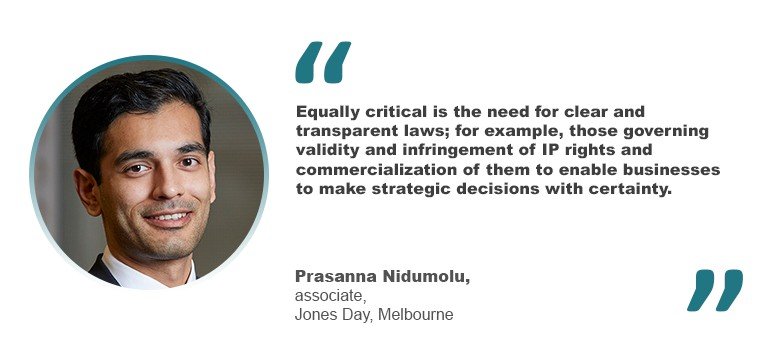
Prasanna Nidumolu, an associate at Jones Day in Melbourne, said: “Equally critical is the need for clear and transparent laws; for example, those governing validity and infringement of IP rights and commercialization of them to enable businesses to make strategic decisions with certainty. Governments also need to be proactive in addressing legal uncertainty when it is observed to negatively impact business confidence, including through prompt statutory reform.”
Elsewhere in Asia, government-sponsored innovation hubs through institutions such as the Hong Kong Trade Development Council, the Singapore Economic Development Board and the Philippine National Development Company offer connections and incentives to attract innovation.
Plus, many jurisdictions have employed tax incentives such as a “patent box” regime to encourage the industrial and R&D sectors, creative industries and intellectual property users to engage in more intellectual property trading activities. In Hong Kong, the Inland Revenue (Amendment) (Tax Concessions for Intellectual Property Income) Ordinance 2024 was enacted on July 5, 2024 (effective for a financial year after April 1, 2023), to provide profits tax concessions for certain assessable profits from an eligible intellectual property income. Such extends to taxpayer’s income derived from patents, utility models and copyrights in software obtained in and outside Hong Kong. Similar schemes exist but at different rates in China, Singapore and Australia, while most countries offer tax relief on qualifying R&D costs.
“Transfer pricing rules limit the extent to which a jurisdiction can offer competing tax concessions without a proper business establishment. As a result, many companies are restructuring their offshore corporate models and moving to more sophisticated jurisdictions such as Hong Kong and Singapore, operating under common law principles and providing double tax relief where appropriate. Hong Kong now has over 50 such double tax treaties compared to 100 in Singapore,” said Wheare.






